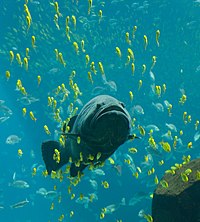
Photo from wikipedia
Silicon carbide (SiC) aerogels are promising thermal insulators that are lightweight and possess high thermal stability. However, their application is hindered by their brittleness. Herein, an air suction effect induction… Click to show full abstract
Silicon carbide (SiC) aerogels are promising thermal insulators that are lightweight and possess high thermal stability. However, their application is hindered by their brittleness. Herein, an air suction effect induction (ASEI) strategy is proposed to fabricate a super thermally insulating SiC aerogel (STISA). The ASEI strategy exploits the air suction effect to subtly regulate the directional flow of the SiO gas, which can induce directional growth and assembly of SiC nanowires to form a directional lamellar structure. The sintering time is significantly reduced by >90%. Significant improvements in the compression and elasticity performance of the STISA are achieved upon the formation of a directional lamellar structure through the ASEI strategy. Moreover, the lamellar structure endows the STISA with an ultralow thermal conductivity of 0.019 W m-1 K-1 . The ASEI strategy paves the way for structural design of advanced ceramic aerogels for super thermal insulation.
Journal Title: Small
Year Published: 2022
Link to full text (if available)
Share on Social Media: Sign Up to like & get
recommendations!